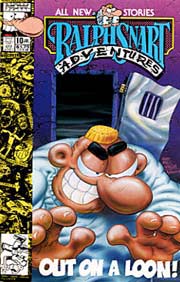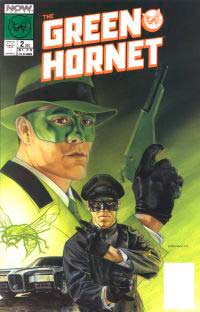An Interview with Tony Caputo
By Alex Ness

Hello readers. As you might know from my past columns and comments, I consider NOW Comics publisher and talent Tony C. Caputo to be a friend. But more than a friendship, I am grateful to him. He was very important in my development as a writer, as shortly after certain events in my writing career occurred, I found myself disappointed, hurt and, frankly, ready to seek a different industry to write about, if I continued writing at all. I sent him an e-mail listing/explaining my struggle. His response was quick, but more importantly, gave me such a boost of confidence and hope that I was able to deal with my Crisis of Infinite Doubts. This interview was done in one sitting through Yahoo Chat, and it was a four hour event.
Caputo is the author of How to Self Publish Your Own Comic Book (WGP, 1997), and Visual Storytelling: the Art and Technique, (WGP, 2003), and currently the creator of the graphic novel VESPERS and President of the self-publishing book publishing company, NOW Media Group, Inc., located in Chicago. When asked to write an article about graphic novels for the popular book web sites independentpublisher.com and bookpublishing.com, Caputo agreed, but 7000 words later, wrote the most comprehensive "white paper"* on comic book publishing in the last twenty years.
The web sites will feature two article excerpts from the white paper; an abridged version of The Comic Book is Dead, Long Live the Comic Book, which introduces the "Five-Headed Monster" that's been wrecking havoc on comic book publishing for years. The other piece called "By the Numbers" is a comprehensive mathematical study of the dollar market shares from 1987 through 2004, using tables, charts and graphs for visual interpretation.
This white paper will be made available as a free download exclusively at www.independentpublisher.com beginning May 5, 2005. It includes specific diagrams and charts with dollar market share as a means of measurement. This white paper is not a how-to guide of comic book publishing, nor does it attempt to explain the many techniques used by the successful companies and entrepreneurs as each have found different paths to success. Instead, it shows how the "Five-Headed Monster" led to an ever declining market, an inevitable paradigm shift, and the growing domination of Manga in the USA.
*A white paper is a published document that explains the results, conclusions, or construction resulting from some organized committee or research collaboration or design and development effort.
Alex Ness: Hi, Tony, and welcome to Thoughts from The Land of Frost.
Tony C. Caputo: Thanks for inviting me up there. I've missed the cold winds of winter...
AN: You have worked in the industry from many vantage points, writer, artist, editor, publisher...how did you start in the industry ?
TCC: I went around showing my artwork to pros for advice when I was a teenager and didn't really have the patience to listen or draw them for that matter. At least how they were supposed to be drawn, so I started publishing a fanzine called FanGraphix, as a hobby, just for fun, really, and found that I enjoyed publishing the fanzine more than drawing at that time.
AN: So, for you, the writing and editing was more rewarding than the art?
TCC: Well...no, not really. it was really more about "design". I wanted to do Pepsi commercials. I wanted to create the most fantastic conceptual design ever achieved by a mere mortal, but I didn't want to wait and pay my dues. I thought that being an artist for a living was the greatest job in the world.
AN: I find it interesting because with your work VESPERS the response I heard was divided either over the writing or over the art. Readers liked or loved one aspect but not the other, and it was not clear why people liked what th

TCC: They're too busy trying to sell a deal in Hollywood and are not focusing on publishing. Nothing wrong with that.
AN: Hell, yeah, there is!!
We are talking comics and when comics people are only interested in hitting it big in film, it is somewhat disrespectful of comics as a stand alone medium.
TCC: Okay, okay. Licensing is one of the Five-Headed Monster. The biggest problem with comic periodicals is that it's a very hard sel. Magazines make most of their revenue from advertising and subscriptions.
AN: So, format is difficult as well. I also know speculators and collectors affected the market...licensing affected the market...format affected the Market...
TCC: So they can afford to ship out a crap load of magazines and shred 70%, just to keep the intellectual property in front of people and get that one or two new subscribers. Comics have never had that. No one ever tried to market it differently, promote them differently for decades...another head of the Five-Headed Monster.
You know, I have this story when Randy Achee came by from Disney to pick my brain
AN: That sounds painful. I hope it was not an ice pick.
TCC: I told him about SLIMER and THE REAL GHOSTBUSTERS comic book ... LOL... it won a Parent's Choice Award. We had this giant box full of about 20,000 submissions to the draw Slimer contest.
AN: Whoa, that is a lot.
TCC: I showed him the great sell through...
AN: I offer free signed comics, I have 5000 readers and I get 100 some entrees in my contest.
TCC: ... and I told him do you want to know what's wrong with this comic book? You get 100 entries -- hey that's great! You can't compare Slimer to that -- this was a hot 80's thing.
AN: Then what is wrong with the comic book though?
TCC: We got more mail from the Draw Slimer Contest than all the other books combined. I got him this quote for a Roger Rabbit Comic Magazine, just a couple cents more to print but it was 8-1/2" x 11" and was going to be distributed as a magazine on the magazine racks. I could not do that with SLIMER because WELSH Publishing had the worldwide rights to the magazine. It would've been the same content - two comics stories written by a school teacher, games, puzzles, poster in the center, and the Draw Slimer Contest Winners. The difference was that I would've been able to DOUBLE the circulation if it were a magazine.
AN: Yoinks!
TCC: I would've gotten subscriptions. Yes -- I could've shipped out 250,000 copies through WPS and still sold 30-40%.
AN: That is awesome.
TCC: But, no... Disney wanted to publish comic books in the direct market that offered 30 days net and not 180 days net.
AN: Disney has failed in that regard numerous times so that musta been somewhat frustrating.
TCC: LOL! NOW Comics was ALWAYS frustrating due to the fact that I published comic books in a country that had absolutely no respect for them.
AN: That ain't easy is it?
TCC: Try explaining to an investor that you're planning on publishing comic books and they used to smile and say "gee, that sounds like fun."
AN: Or kids read mature titles?
TCC: Or...They still publish those?
AN: Right. I think that in Europe you'd have been lauded for your efforts.
TCC: Every single investor I ever talked to looked at the direct market as candy, especially when we hit it big, and I didn't even know it because I was too busy being publisher and not president. I used to tell these potential investors - ah...yeah, we get about $300,000 to $500,000 a month four days before we ship the books so they can take advantage of them.

TCC: We didn't pay creators much of anything and his comment about being owed "royalties" for the TPB is probably more "I deserve this" rather than "I was contractually obligated." No one got reprint royalties. Geez, what a bookkeeping nightmare that would've been. If he's owed money, it's from the bankruptcy estate and not me. Hell, I didn't see a dime either. all the lawyers took whatever there was there.
AN: A bankruptcy decision would take care of outstanding issues? So, Tony, you tell me you addressed the life and death of the comic book industry in a white paper. What are the five heads of the five-headed beast who killed the market?
TCC: First of all, it's killing the market and has been for decades. It's not totally dead, yet. The first head is the Speculator, which can be the individual collector to the individual investor-- each one has only one primary objective - profit, fast and big.
AN: So they never read a comic just buy it
TCC: Nope. Not all of them at least. There may be one or two that tickle their fancy, but that's not their main driving force.
The second head of the Five-Headed Monster is the "lack of marketing for the comic book as an entertainment choice." This is where I think Mr. T did more for comic books in 1993 when he appeared on Entertainment Tonight HOLDING A COMIC BOOK.
AN: I.e. the lack of competitiveness as an entertainment source?
TCC: Where's the picture of Johnny Depp holding a FROM HELL graphic novel? Or Tom Hanks holding a Road to Perdition GN? The lack of respect. There're all these closet comic book fans that wouldn't be caught dead in public with one. You have photos of Ashton Kutcher wearing a Jesus t-shirt and, suddenly, Jesus is cool. Brad Pitt carrying Red Vines and sales increase 30%. Where are the comic books?
AN: In the dark little room out back.
TCC: The Third head of the Five-Headed Monster is the Superhero, who is really a supervillian dominating the medium for decades not making any room for anything else. Case in point - Ralph Snart
AN: Hmmm
TCC: Ralph Snart sold three times better on the newsstand than in the direct market because the direct market preferred superheroes. The newsstand never saw anything like Ralph Snart before.
AN: Or since?
TCC: That's why those fans never picked up anything else. There were a few I noticed that said they picked up Terminator.
AN: But does a customer's taste drive out other product?
TCC: Again, not a superhero comic
AN: I mean, there is a great need to acknowledge that, I think.
TCC: Customer's taste? That customer taste's are modeled in inventory in a store. You mean the only people with enough courage to walk into a comic book shop?
AN: Case in point, a retailer I know started his store, had 80% stock in comics, 10% games, 10% cards. 10 years later, 50% games, 25% comics, 25% cards. He does not like cards or games, so you cannot argue that he is trying to manipulate the market to his taste. So, whose taste is being represented?
TCC: There is a very big difference between a comic book shop and a newsstand outlet
AN: So, aren't the presence of superheroes in comics just an avenue of taste? How so, Tony?
TCC: Comic book shops were made, invented, and catered to the comic book collector and already converted Marvel or DC reader. These are people who have already picked up their comics off the newsstand when they were a kid and decided that it would be safer to buy them at a comic shop to make sure they have the ones they want and also so their aren't cute girls watching them. Oh, man, can you imagine if you had to buy tampons, too??
AN: I have.

